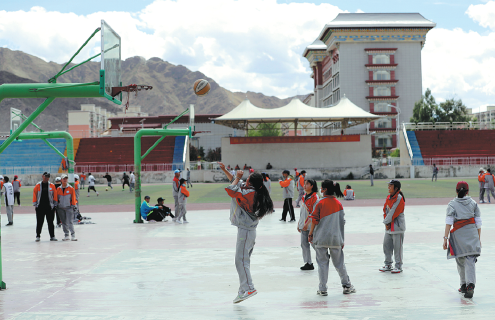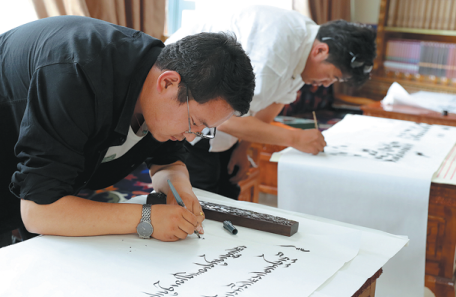Tibet hits an education high
Schools make adjustments to provide better opportunities for students from the region's elevated altitudes, Xu Lin reports.
In a backdrop of rolling mountains, students in uniform are playing basketball on the playground, and several others are learning how to skate at the Nagchu No 2 Senior High School in Lhasa, capital of the Tibet autonomous region.
Covering an area of 14.92 hectares, the boarding school was built in 2014 and only recruits students from Nagchu city. There are 58 classes with over 3,100 students and 285 teachers.
A vast territory with a sparse population, Nagchu has an average altitude of more than 4,500 meters. In comparison, Lhasa has a lower altitude of 3,650 meters, which is advantageous in many aspects.
"Due to Nagchu's high altitude, the weather is cold and oxygen is lacking. It's not good for one's health if one works there for a long time, so it makes it hard to retain teachers," says Penpa, the school's principal.
"In Lhasa, it's easier to strengthen academic communication with other schools to boost the development of our school. Students can also develop in an all-around way and broaden their horizons."
He says Nagchu has built three such senior high schools in Lhasa and a new one is currently under construction. Tibet's Ngari prefecture, a high-altitude area, has also built two senior high schools in Lhasa, learning from Nagchu's success.
Students of Nagchu No 2 Senior High School are all Tibetan, with more than 95 percent of them children of farmers and herders. They are benefiting from the country's Three Guarantees policy for education in Tibet.
Under the policy, food, accommodation and school expenses are provided for preschool to senior high school students from farming and herding households and impoverished urban families. The annual subsidy has also risen to an average of 4,200 yuan ($656) per student.
During summer and winter vacations, their round-trip train tickets to Nagchu are also covered.
In May, the State Council Information Office released a white paper on Tibet, marking the 70th anniversary of its peaceful liberation.
The paper states that "there was not a single proper school" in old Tibet. The illiteracy rate exceeded 95 percent. From 1951 to 2020, the central government invested 224 billion yuan in Tibet's education system. At present, Tibet has 3,195 schools of various types and at various levels, serving more than 790,000 students.
Basic and balanced development of compulsory education has been realized in all counties. The completion rate for compulsory education has also reached 95 percent.
Fan Chunwen, an official from Tibet's education department, says many people have changed their destinies and live happy lives, benefiting from the education system in Tibet.
"Multimedia education covers all primary and middle schools in Tibet. Even in a remote school, students can have access to such interactive classes," Fan says.
Penpa says the school offers dual education courses, with at least 14 classes a week in Tibetan language and Mandarin respectively. Students can read bilingual books of various themes at the school's library.
"Both languages are important for students. Languages have their own dynamic development when they're often used, so does culture," he says. "For example, Chinese has many loanwords from English. In Chinese, hada is a borrowed word from Tibetan." Hada is a piece of white silk used as a greeting gift among Tibetan people.
Namse Gonpo, a 17-year-old senior second grade student, says the circumstances in Lhasa are better due to its relatively lower altitude, and he has soon adjusted to life here. His parents are supportive of him furthering his studies in the school.
"Compared with my parents' generation, our generation has much better opportunities to receive education and enjoy higher living standards, thanks to the motherland's prosperity," he says.
The school has about a dozen recreational clubs ranging from basketball to ping-pong and jazz dance, enriching school life. Namse Gonpo has joined the broadcast club and speaks fluent Mandarin.
Like his schoolmates, he is bilingual. He uses Tibetan language to communicate with his parents, who feel more comfortable speaking in their native tongue.
"At school, if I discuss content about Tibetan class with classmates, we use the Tibetan language. If we talk about hot issues like news, we prefer to speak in Mandarin," he says.
He wants to go to university in other regions of China and come back to work in his hometown Nagchu to contribute to its development.
Namse Gonpo is not afraid that Tibetan culture may be on the decline.
"The Tibetan culture is always developing, and we can better learn about our culture," he says.
Liu Shuai is among the school's 20 teachers who have come from other parts of China to support the development of Tibet's education system as part of a nationwide campaign to help the border region achieve change step by step.
"A teacher's duty is to impart knowledge and educate people. That's why I applied for the position here," says the 31-year-old Liu from Dalian, Liaoning province.
He says compared with their peers from other places in China, students in Tibet have a relatively weaker grasp of fundamental knowledge, so he has to combine his previous teaching experience with the needs of the students to help them achieve academic progress. He also trains local teachers to improve their professional skills.
"My three-year tenure in Tibet will be the greatest wealth of my life. I can never have such teaching experience in other regions of China, and it's beneficial to both my personal development and teaching career," he says.
People may feel uncomfortable when they first come to a high-altitude region, and may have altitude sickness, for instance. Liu, who has lived in Lhasa for two years, was recently diagnosed with gout. He was a bit depressed and started to doubt himself, but he eventually made adjustments for his well-being.
"It's just one of the difficulties that I have encountered on the plateau," he says. "It's essential to stick to a teacher's original intention-to train talent."
Contact the writer at xulin@chinadaily.com.cn




